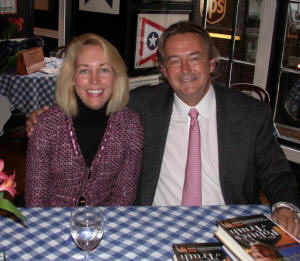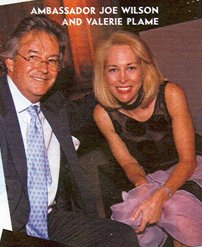|
Site Map VALERIE PLAME |
|
by Wikipedia Valerie Plame with her husband Joseph C. Wilson, photographed after her CIA identity became public knowledge.
Valerie Plame Wilson[1]
(born
April 19,
1963) is a
United States
Central Intelligence Agency officer, who was identified as a CIA
operative in a newspaper column by
Robert Novak on
July 14,
2003. The
ensuing political controversy, commonly referred to as the
Plame affair, or the CIA leak scandal, led, in late
2003, to a
Justice Department investigation into possible violation of criminal
statutes, including the
Intelligence Identities Protection Act of
1982.
BackgroundOn April 3, 1998, Plame became the third wife of former Ambassador Joseph C. Wilson IV. Plame met Wilson, her second husband, at a Washington D.C party in early 1997. She was able to reveal her CIA role to him while they were dating because he held a high-level security clearance. At the time, Wilson was separated from his second wife Jacqueline, a former French diplomat. Wilson and Plame are the parents of five-year-old twins.
Plame, date similar to photo above. EducationPlame is a graduate of Pennsylvania State University in 1985, the London School of Economics and Political Science, UK, and the College of Europe, an international-relations school in Bruges. Soon after graduation, she started working for the U.S. government in Washington D.C. During her time at Penn State, she had worked on the business side of PSU's student newspaper, The Daily Collegian. According to an October 9, 2003 Collegian article, she previously attended Lower Moreland High School in Huntingdon Valley, Montgomery County, Pennsylvania. [2] CareerLittle is known of Plame's professional career. While undercover, she had described herself as an "energy analyst" for the private company "Brewster Jennings & Associates," which the CIA later acknowledged was a front company for certain investigations. "Brewster Jennings" was first entered into Dun and Bradstreet records on May 22, 1994, but D&B would not discuss the source of the filing. D&B records list the company as a "legal services office," located at 101 Arch Street, Boston Massachusetts. One former CIA official, Larry C. Johnson, identified Plame as a "non-official cover operative" (NOC). He explained: "...that meant she agreed to operate overseas without the protection of a diplomatic passport. If caught in that status she would have been executed." [3] David Armstrong, an Andover researcher for the Public Education Center, believed that the Brewster Jennings & Associates cover had not been done convincingly and that other covers would have been established for her by the CIA. [4] It has been speculated that Plame likely would have worked in the office of former CIA Deputy Director of Operations (DDO) James Pavitt. Plame affair
In the first official criticism of the plan to invade Iraq during late 2002, Joseph C. Wilson, —Plame's husband and a Bush I administration official — wrote an Op-Ed in the New York Times in which he claimed that he had found no evidence of Iraqi pursuit of nuclear material during his trip to Africa. He also criticized the administration for using allegedly unreliable documents (Yellowcake forgery) to make its case against Iraq. The Senate Intelligence Committee Report of July 2004, however, indicates that Wilson's piece did not convey a truthful account of his findings in Africa. It is also not known whether the documents in question are genuine and, even if they are not, whether they were a substantial part of the evidence for Iraqi interest in nuclear material. Syndicated columnist Robert Novak described Plame as "an Agency operative on weapons of mass destruction" in a July 2003 column. Other journalists have also mentioned her identity. The revelation of Plame's identity —which some have argued was by Bush administration officials in response to Wilson's criticism —is the basis for the "Plame affair" (aka. "CIA leak scandal"). US Attorney Patrick Fitzgerald is investigating the events surrounding the naming of Valerie Plame to determine if any crimes were committed in the process. See alsoExternal links
Related SourceWatch articles
References
|

